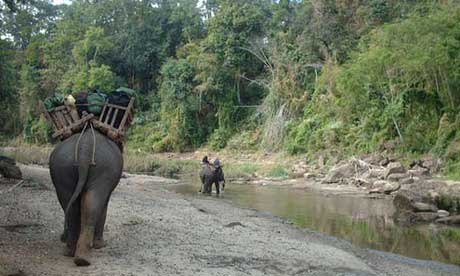
Deciding where – and how – funding for wildlife preservation is placed is fraught with pitfalls, as a trip to Alaungdaw Kathapa National Park shows
It’s impossible to look professional while sitting on an elephant. I’ve tried countless times and have always failed miserably.
I’ve just returned from Alaungdaw Kathapa National Park, in Burma (Myanmar), and yet again found myself slumped in one of those horribly familiar wooden cradles perched on an elephant’s back, clinging on with both hands, with my knees wrapped around my neck and my camera swinging backwards and forwards like a wrecking ball.
The mahout, meanwhile, sat there as relaxed as a member of the Royle Family slouched in front of the TV.
I’d just arrived from Mandalay, nearly 200km to the south-west, and welcomed the sudden peace and quiet. Burma’s second-largest city had been celebrating the annual Water Festival, marked by one of the best mass water-fights on the planet. I’d arrived in town along with tens of thousands of people who’d travelled from all over the country merely to get wet.
Half of them lined the streets armed with water-filled buckets, water pistols and heavy-duty hoses, while the other half paraded up and down on bicycles, mopeds, trucks and buses, longing to get drenched.
If you’re trying to get to work, you’re going to arrive wet. And if you’re a rarely spotted Westerner you’re going to get even wetter. But with the air temperature pushing 50°C a good soaking was the best possible way to spend the day – and worth it just to see the locals scream and laugh in delight.
I was in Alaungdaw, a magical 1,605 sq km of mixed deciduous forest and tropical jungle, to join an anti-poaching patrol. Burma’s first national park, founded in 1984, is home to elephant, wild dog, Malaysian sun bear, clouded leopard and a host of other wildlife. It was once home to tigers, too, but thanks to rampant poaching none have been seen for years.
I didn’t see any wildlife at all, apart from fleeting glimpses of a rapidly retreating rhesus monkey and a brown bundle of fur dashing across a forest glade. Alaungdaw isn’t like parks and reserves in neighbouring India, where wildlife sightings are virtually guaranteed. Its animals are rarer and shyer and prefer to keep to themselves.
Perhaps it’s not surprising. The ever-increasing human population around Alaungdaw puts huge pressure on the park’s natural resources. Poaching for rare and endangered species, hunting for bushmeat, firewood collection and commercial timber extraction have all taken a terrible toll.
The David Shepherd Wildlife Foundation, working with the Forest Resource Environment Development and Conservation Association (FREDA) and the government’s Forest Department, is doing everything possible to protect the park. In many ways, it’s a model project. Professionally run, complete with paramilitary-trained anti-poaching patrols, it even has a community programme that ticks all the right boxes.
But despite everyone’s best efforts, the gradual deterioration of the park continues. The tigers have gone, never to return. The elephant population has dropped from about 150 in the mid-1980s to fewer than 40 today. And so on. Protecting a park of this size, when it faces so many threats, is an uphill struggle – and it’s almost impossible given the minuscule number of forest rangers (50-60) available for the task.
So what’s to be done? Should funding continue in the hope that things will improve? Should more money be found to raise the odds of success? Is it just going into a big black hole? Should funds be diverted to areas where the wildlife has a better chance of survival? It’s an impossible dilemma. But it’s one facing conservationists more and more often, worldwide.